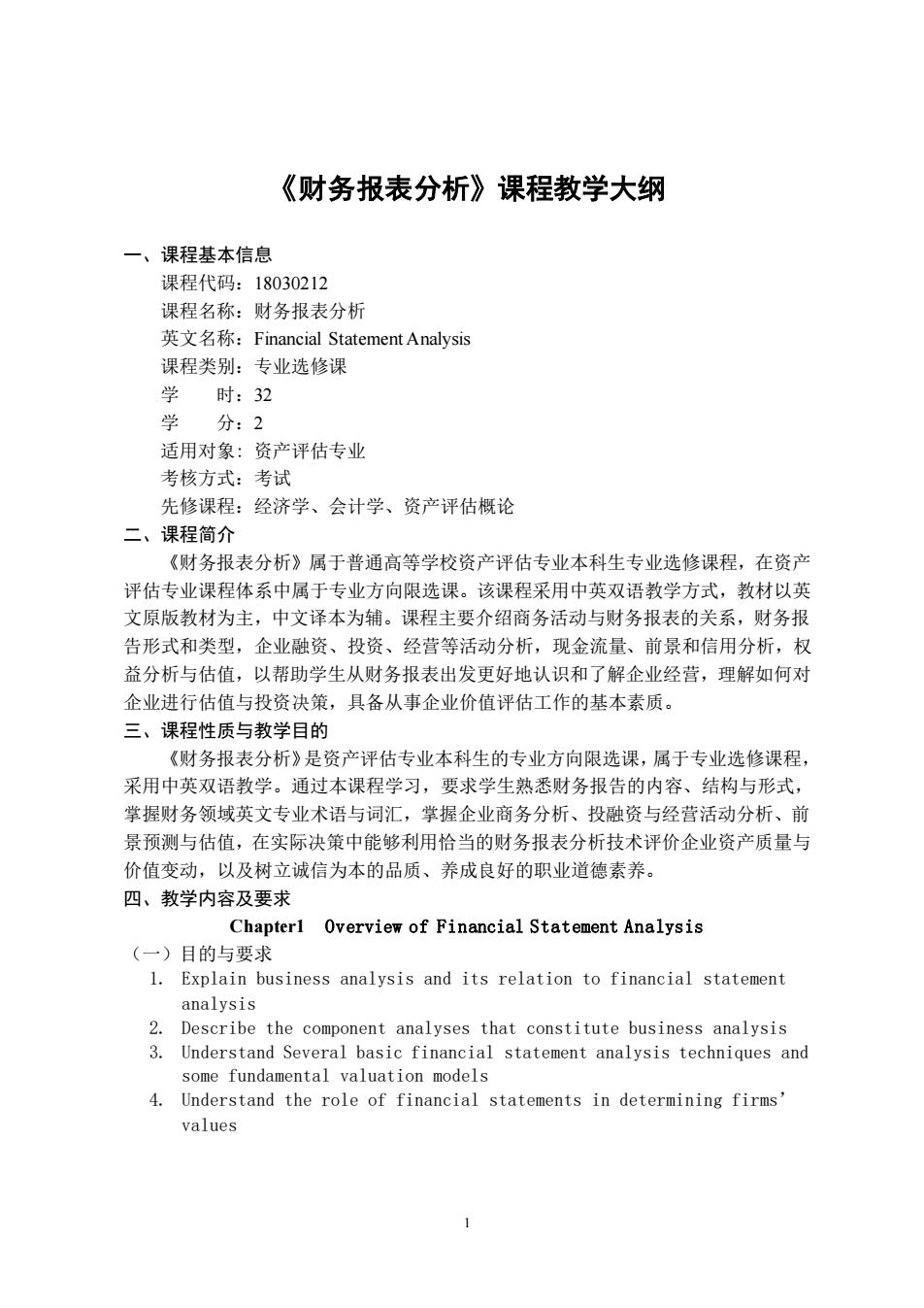
《财务报表分析》课程教学大纲 一、课程基本信息 课程代码:18030212 课程名称:财务报表分析 英文名称:Financial Statement Analysis 课程类别:专业选修课 时:32 学 分:2 适用对象:资产评估专业 考核方式:考试 先修课程:经济学、会计学、资产评估概论 二、课程简介 《财务报表分析》属于普通高等学校资产评估专业本科生专业选修课程,在资产 评估专业课程体系中属于专业方向限选课。该课程采用中英双语教学方式,教材以英 文原版教材为主,中文译本为辅。课程主要介绍商务活动与财务报表的关系,财务报 告形式和类型,企业融资、投资、经营等活动分析,现金流量、前景和信用分析,权 益分析与估值,以帮助学生从财务报表出发更好地认识和了解企业经营,理解如何对 企业进行估值与投资决策,具备从事企业价值评估工作的基本素质。 三、课程性质与教学目的 《财务报表分析》是资产评估专业本科生的专业方向限洗课,属干专业洗修课程 采用中英双语教学。通过本课程学习,要求学生熟悉财务报告的内容、结构与形式, 掌握财务领域英文专业术语与词汇,掌握企业商务分析、投融资与经营活动分析、前 景预测与估值,在实际决策中能够利用恰当的财务报表分析技术评价企业资产质量与 价值变动,以及树立诚信为本的品质、养成良好的职业道德素养。 四、教学内容及要求 Chapterl Overview of Financial Statement Analysis (一)目的与要求 1.Explain business analysis and its relation to financial statement analysis 2.Describe the component analyses that constitute business analysis 3.Understand Several basic financial statement analysis techniques and some fundamental valuation models 4.Understand the role of financial statements in determining firms' values 1
1 《财务报表分析》课程教学大纲 一、课程基本信息 课程代码:18030212 课程名称:财务报表分析 英文名称:Financial Statement Analysis 课程类别:专业选修课 学 时:32 学 分:2 适用对象: 资产评估专业 考核方式:考试 先修课程:经济学、会计学、资产评估概论 二、课程简介 《财务报表分析》属于普通高等学校资产评估专业本科生专业选修课程,在资产 评估专业课程体系中属于专业方向限选课。该课程采用中英双语教学方式,教材以英 文原版教材为主,中文译本为辅。课程主要介绍商务活动与财务报表的关系,财务报 告形式和类型,企业融资、投资、经营等活动分析,现金流量、前景和信用分析,权 益分析与估值,以帮助学生从财务报表出发更好地认识和了解企业经营,理解如何对 企业进行估值与投资决策,具备从事企业价值评估工作的基本素质。 三、课程性质与教学目的 《财务报表分析》是资产评估专业本科生的专业方向限选课,属于专业选修课程, 采用中英双语教学。通过本课程学习,要求学生熟悉财务报告的内容、结构与形式, 掌握财务领域英文专业术语与词汇,掌握企业商务分析、投融资与经营活动分析、前 景预测与估值,在实际决策中能够利用恰当的财务报表分析技术评价企业资产质量与 价值变动,以及树立诚信为本的品质、养成良好的职业道德素养。 四、教学内容及要求 Chapter1 Overview of Financial Statement Analysis (一)目的与要求 1. Explain business analysis and its relation to financial statement analysis 2. Describe the component analyses that constitute business analysis 3. Understand Several basic financial statement analysis techniques and some fundamental valuation models 4. Understand the role of financial statements in determining firms’ values
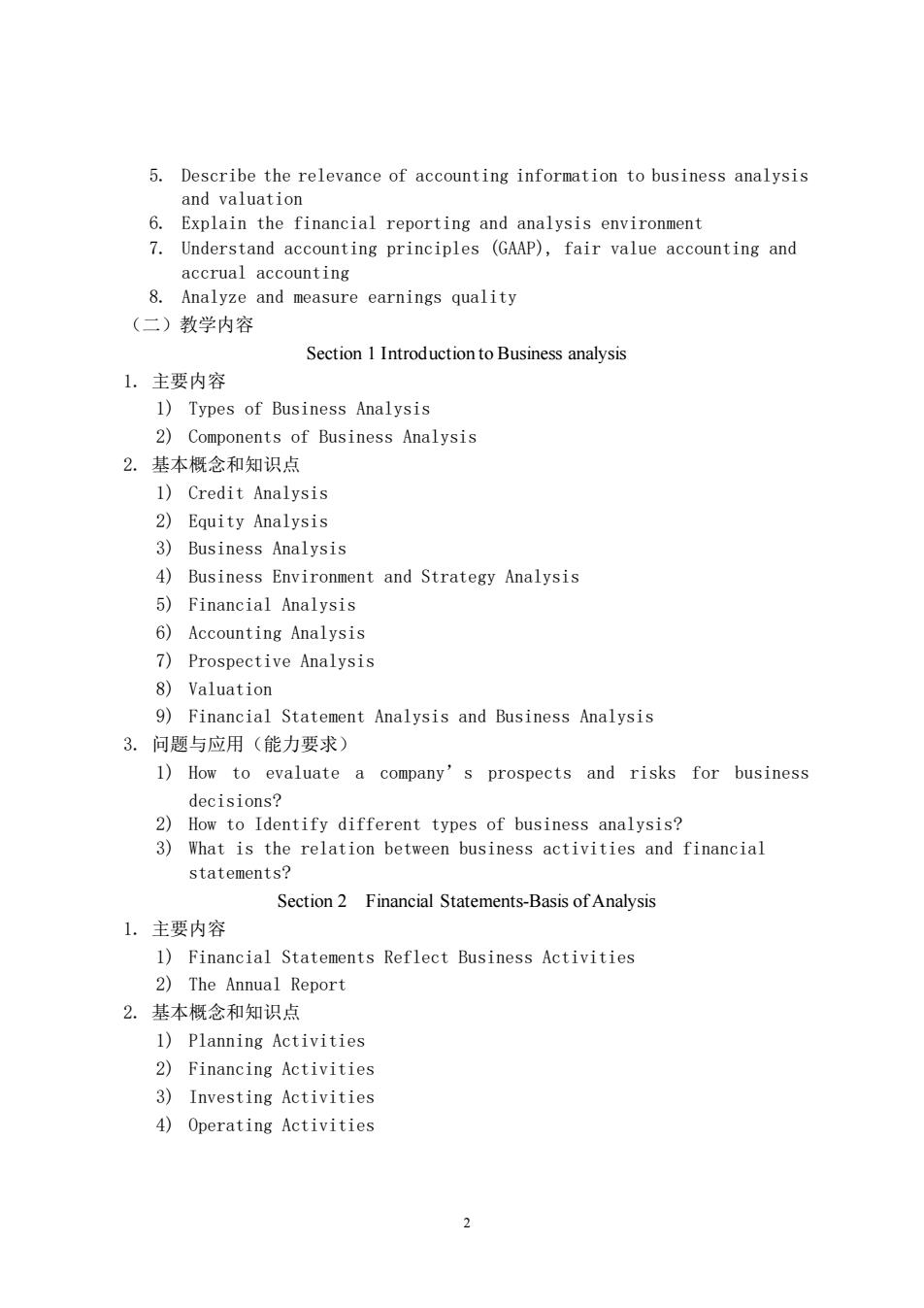
5.Describe the relevance of accounting information to business analysis and valuation 6.Explain the financial reporting and analysis environment 7.Understand accounting principles (GAAP),fair value accounting and accrual accounting 8.Analyze and measure earnings quality (二)教学内容 Section I Introduction to Business analysis 1.主要内容 1)Types of Business Analysis 2)Components of Business Analysis 2.基本概念和知识点 1)Credit Analysis 2)Equity Analysis 3)Business Analysis 4)Business Environment and Strategy Analysis 5)Financial Analysis 6)Accounting Analysis 7)Prospective Analysis 8)Valuation 9)Financial Statement Analysis and Business Analysis 3.问题与应用(能力要求) 1)How to evaluate a company's prospects and risks for business decisions? 2)How to Identify different types of business analysis? 3)What is the relation between business activities and financial statements? Section 2 Financial Statements-Basis of Analysis 1.主要内容 1)Financial Statements Reflect Business Activities 2)The Annual Report 2.基本概今和知识点 1)Planning Activities 2)Financing Activities 3)Investing Activities 4)Operating Activities
2 5. Describe the relevance of accounting information to business analysis and valuation 6. Explain the financial reporting and analysis environment 7. Understand accounting principles (GAAP), fair value accounting and accrual accounting 8. Analyze and measure earnings quality (二)教学内容 Section 1 Introduction to Business analysis 1. 主要内容 1) Types of Business Analysis 2) Components of Business Analysis 2. 基本概念和知识点 1) Credit Analysis 2) Equity Analysis 3) Business Analysis 4) Business Environment and Strategy Analysis 5) Financial Analysis 6) Accounting Analysis 7) Prospective Analysis 8) Valuation 9) Financial Statement Analysis and Business Analysis 3. 问题与应用(能力要求) 1) How to evaluate a company’s prospects and risks for business decisions? 2) How to Identify different types of business analysis? 3) What is the relation between business activities and financial statements? Section 2 Financial Statements-Basis of Analysis 1. 主要内容 1) Financial Statements Reflect Business Activities 2) The Annual Report 2. 基本概念和知识点 1) Planning Activities 2) Financing Activities 3) Investing Activities 4) Operating Activities
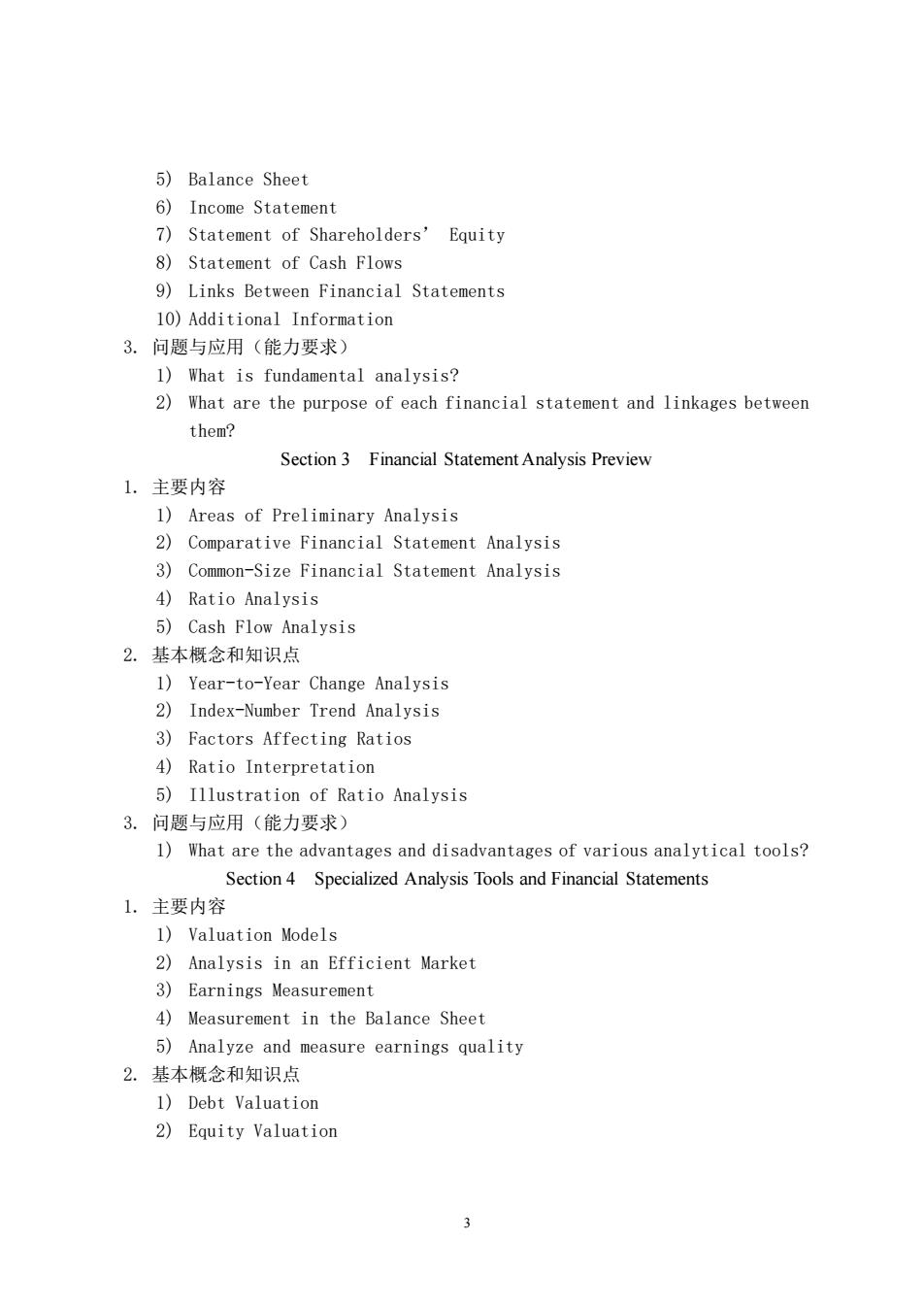
5)Balance Sheet 6)Income Statement 7)Statement of Shareholders'Equity 8)Statement of Cash Flows 9)Links Between Financial Statements 10)Additional Information 3.问题与应用(能力要求) 1)What is fundamental analysis? 2)What are the purpose of each financial statement and linkages between them? Section 3 Financial Statement Analysis Preview 1.主要内容 1)Areas of Preliminary Analysis 2)Comparative Financial Statement Analysis 3)Common-Size Financial Statement Analysis 4)Ratio Analysis 5)Cash Flow Analysis 2.基本概念和知识点 1)Year-to-Year Change Analysis 2)Index-Number Trend Analysis 3)Factors Affecting Ratios 4)Ratio Interpretation 5)Illustration of Ratio Analysis 3.问题与应用(能力要求) 1)What are the advantages and disadvantages of various analytical tools? Section 4 Specialized Analysis Tools and Financial Statements 1.主要内容 1 Valuation Models 2)Analysis in an Efficient Market 3)Earnings Measurement 4)Measurement in the Balance Sheet 5)Analyze and measure earnings quality 2.基本概念和知识点 1)Debt Valuation 2)Equity Valuation 3
3 5) Balance Sheet 6) Income Statement 7) Statement of Shareholders’ Equity 8) Statement of Cash Flows 9) Links Between Financial Statements 10) Additional Information 3. 问题与应用(能力要求) 1) What is fundamental analysis? 2) What are the purpose of each financial statement and linkages between them? Section 3 Financial Statement Analysis Preview 1. 主要内容 1) Areas of Preliminary Analysis 2) Comparative Financial Statement Analysis 3) Common-Size Financial Statement Analysis 4) Ratio Analysis 5) Cash Flow Analysis 2. 基本概念和知识点 1) Year-to-Year Change Analysis 2) Index-Number Trend Analysis 3) Factors Affecting Ratios 4) Ratio Interpretation 5) Illustration of Ratio Analysis 3. 问题与应用(能力要求) 1) What are the advantages and disadvantages of various analytical tools? Section 4 Specialized Analysis Tools and Financial Statements 1. 主要内容 1) Valuation Models 2) Analysis in an Efficient Market 3) Earnings Measurement 4) Measurement in the Balance Sheet 5) Analyze and measure earnings quality 2. 基本概念和知识点 1) Debt Valuation 2) Equity Valuation
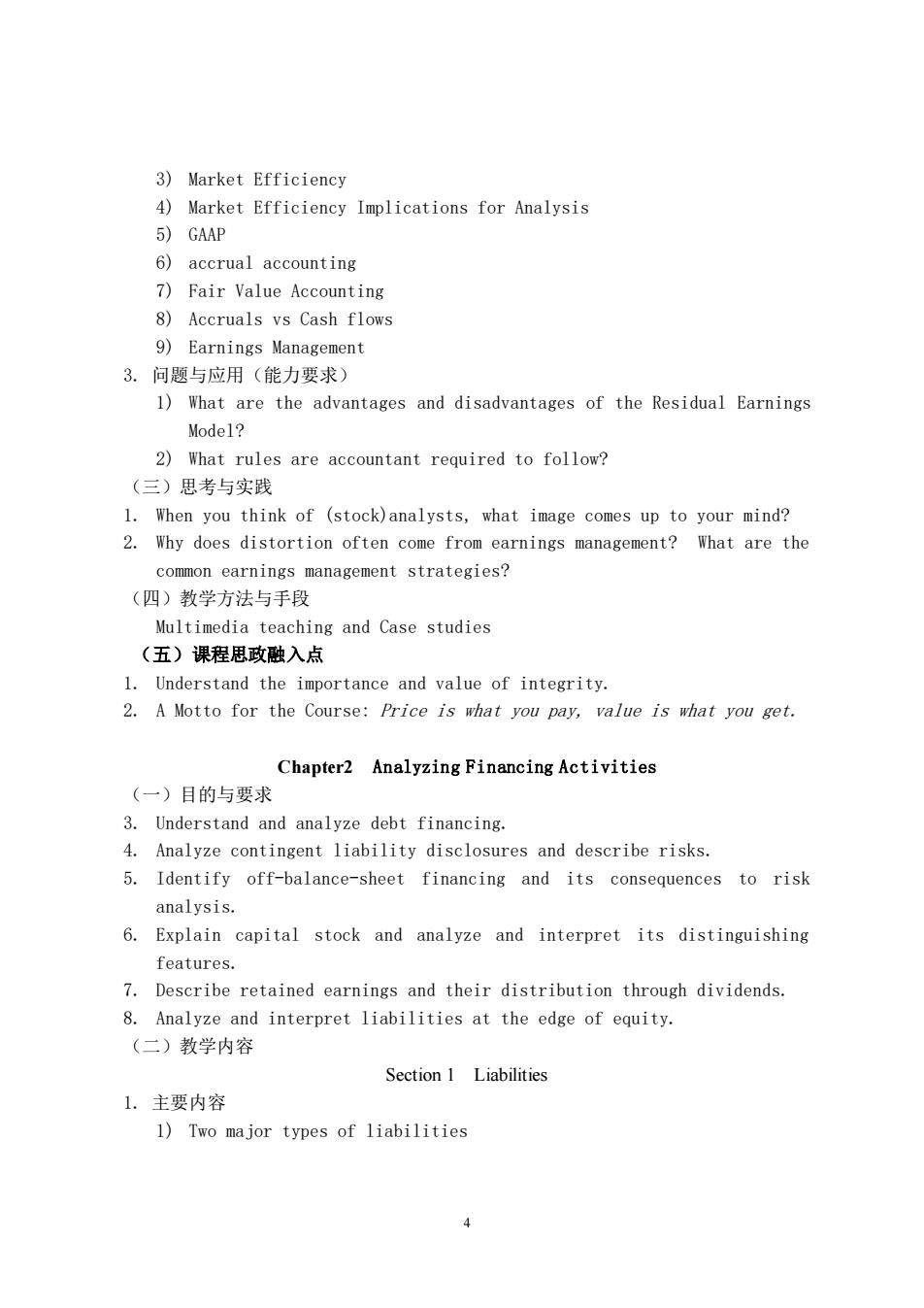
3)Market Efficiency 4)Market Efficiency Implications for Analysis 5)GAAP 6)accrual accounting 7)Fair Value Accounting 8)Accruals vs Cash flows 9)Earnings Management 3.问题与应用(能力要求) 1)What are the advantages and disadvantages of the Residual Earnings Mode1? 2)What rules are accountant required to follow? (三)思考与实践 1.When you think of (stock)analysts,what image comes up to your mind? 2.Why does distortion often come from earnings management?What are the common earnings management strategies? (四)教学方法与手段 Multimedia teaching and Case studies (五)课程思政融入点 1.Understand the importance and value of integrity. 2.A Motto for the Course:Price is what you pay,value is what you get. Chapter2 Analyzing Financing Activities (一)目的与要求 3.Understand and analyze debt financing. 4.Analyze contingent liability disclosures and describe risks. 5.Identify off-balance-sheet financing and its consequences to risk analysis. 6.Explain capital stock and analyze and interpret its distinguishing features. 7.Describe retained earnings and their distribution through dividends. 8.Analyze and interpret liabilities at the edge of equity. (一)数学内容 Section 1 Liabilities 1.主要内容 1)Two major types of liabilities 4
4 3) Market Efficiency 4) Market Efficiency Implications for Analysis 5) GAAP 6) accrual accounting 7) Fair Value Accounting 8) Accruals vs Cash flows 9) Earnings Management 3. 问题与应用(能力要求) 1) What are the advantages and disadvantages of the Residual Earnings Model? 2) What rules are accountant required to follow? (三)思考与实践 1. When you think of (stock)analysts, what image comes up to your mind? 2. Why does distortion often come from earnings management? What are the common earnings management strategies? (四)教学方法与手段 Multimedia teaching and Case studies (五)课程思政融入点 1. Understand the importance and value of integrity. 2. A Motto for the Course: Price is what you pay, value is what you get. Chapter2 Analyzing Financing Activities (一)目的与要求 3. Understand and analyze debt financing. 4. Analyze contingent liability disclosures and describe risks. 5. Identify off-balance-sheet financing and its consequences to risk analysis. 6. Explain capital stock and analyze and interpret its distinguishing features. 7. Describe retained earnings and their distribution through dividends. 8. Analyze and interpret liabilities at the edge of equity. (二)教学内容 Section 1 Liabilities 1. 主要内容 1) Two major types of liabilities
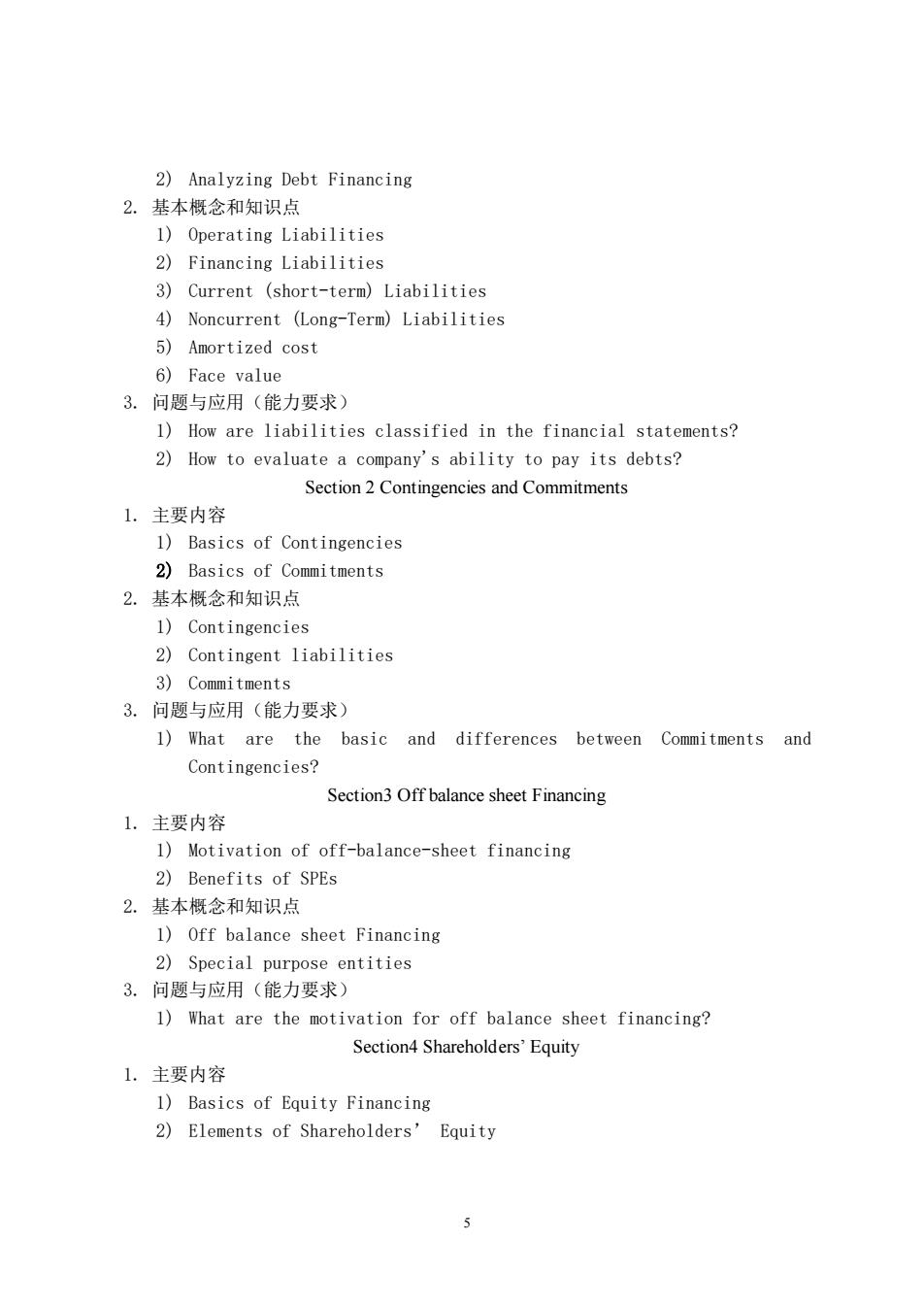
2)Analyzing Debt Financing 2.基本概念和知识点 1)Operating Liabilities 2)Financing Liabilities 3)Current (short-term)Liabilities 4)Noncurrent (Long-Term)Liabilities 5)Amortized cost 6)Face value 3.问题与应用(能力要求) 1)How are liabilities classified in the financial statements? 2)How to evaluate a company's ability to pay its debts? Section 2 Contingencies and Commitments 1.主要内容 1)Basics of Contingencies 2)Basics of Commitments 2.基本概念和知识点 1)Contingencies 2)Contingent liabilities 3)Commitments 3.问题与应用(能力要求) 1)What are the basic and differences between Commitments and Contingencies? Section3 Off balance sheet Financing 1.主要内容 1)Motivation of off-balance-sheet financing 2)Benefits of SPEs 2.基本概念和知识点 d Off balance sheet financing 2)Special purpose entities 3.问题与应用(能力要求) 1)What are the motivation for off balance sheet financing? Section4 Shareholders'Equity 1.主要内容 1)Basics of Equity Financing 2)Elements of Shareholders'Equity 5
5 2) Analyzing Debt Financing 2. 基本概念和知识点 1) Operating Liabilities 2) Financing Liabilities 3) Current (short-term) Liabilities 4) Noncurrent (Long-Term) Liabilities 5) Amortized cost 6) Face value 3. 问题与应用(能力要求) 1) How are liabilities classified in the financial statements? 2) How to evaluate a company's ability to pay its debts? Section 2 Contingencies and Commitments 1. 主要内容 1) Basics of Contingencies 2) Basics of Commitments 2. 基本概念和知识点 1) Contingencies 2) Contingent liabilities 3) Commitments 3. 问题与应用(能力要求) 1) What are the basic and differences between Commitments and Contingencies? Section3 Off balance sheet Financing 1. 主要内容 1) Motivation of off-balance-sheet financing 2) Benefits of SPEs 2. 基本概念和知识点 1) Off balance sheet Financing 2) Special purpose entities 3. 问题与应用(能力要求) 1) What are the motivation for off balance sheet financing? Section4 Shareholders’ Equity 1. 主要内容 1) Basics of Equity Financing 2) Elements of Shareholders’ Equity